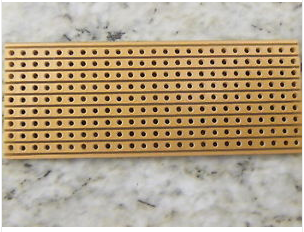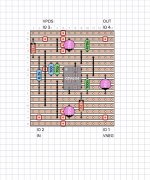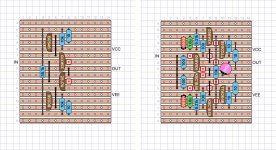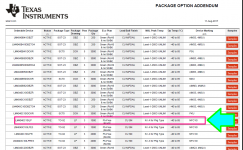There seems to be three LT1122 in PDIP-8 listed at Mouser . Priced from $8.42 to $15.48 which one do you recommend? I have the two listed on BOM and would try this next order I put in. Any comments on comparisons to say the OPA1611? thanks
Check the datasheet that Mark provided and the best one to order will be clear.
One way to get more Tucson boards is to buy a complete set of all 12 PCBs from the Store. Use the Tucsons and sell the rest.
Another way to get more Tucson boards is to communicate with one of the many M2x builders who only populated and soldered Ishikawa (but none of the other four input stages). Ask them if they will sell or make a trade for their blank Tucson boards.
Another way to get more Tucson boards is to find the old thread in the Swap Meet area of these Forums, where extra Tucson boards were sold and bought. Notice the forum usernames of the buyers (one guy bought eighteen Tucson boards! Really!), and send each of them a Private Message, asking to buy a couple of their extra Tucsons.
Another way to get more Tucson boards is to build them yourself on Stripboard / Veroboard. Earlier this year an M2x builder named "Tungsten Audio" posted his Stripboard place-and-route for all five M2x daughter cards. Naturally Tucson was one of them. He showed an early example in post #1743 and I think he refined it a couple of times after that.
And of course the riskiest way is to un-solder the existing DIP from the existing Tucson board, and replace it by a socket.
Perhaps Forum members have additional suggestions ....

Another way to get more Tucson boards is to communicate with one of the many M2x builders who only populated and soldered Ishikawa (but none of the other four input stages). Ask them if they will sell or make a trade for their blank Tucson boards.
Another way to get more Tucson boards is to find the old thread in the Swap Meet area of these Forums, where extra Tucson boards were sold and bought. Notice the forum usernames of the buyers (one guy bought eighteen Tucson boards! Really!), and send each of them a Private Message, asking to buy a couple of their extra Tucsons.
Another way to get more Tucson boards is to build them yourself on Stripboard / Veroboard. Earlier this year an M2x builder named "Tungsten Audio" posted his Stripboard place-and-route for all five M2x daughter cards. Naturally Tucson was one of them. He showed an early example in post #1743 and I think he refined it a couple of times after that.
And of course the riskiest way is to un-solder the existing DIP from the existing Tucson board, and replace it by a socket.
Perhaps Forum members have additional suggestions ....
Yes, it so happens that I was revisiting my Vero board design with the new opamp in mind. Here is an updated version of the Tuscon THD layout. It has provision for a simple compensating resistor and cap in the unity gain feedback loop, which may not be necessary in most cases. The 100 Ohm resistor may be replaced with a jumper wire, and the 10p cap deleted.
Attachments
I have been exploring some alternate layouts for a couple of the input buffers. These have some advantages from rearranging the I/O and power ports. The ideas started when I was designing alternate input buffers for an F6 amp with increased power rail voltage. There is also potential for adapting these to the M2x, perhaps with the help of a mezzanine interface board.
One is a cascode JFet buffer with no source degeneration on the JFets. This might be a higher voltage version of the Ishikawa IPS. The second is an alternate layout of the Diamond buffer, which addresses the borderline high power dissipation of the output devices. I haven't tried either of these yet, but the JFet cascode will probably appear first in my F6. These might be fun for some of the more intrepid amp builders out there.
One is a cascode JFet buffer with no source degeneration on the JFets. This might be a higher voltage version of the Ishikawa IPS. The second is an alternate layout of the Diamond buffer, which addresses the borderline high power dissipation of the output devices. I haven't tried either of these yet, but the JFet cascode will probably appear first in my F6. These might be fun for some of the more intrepid amp builders out there.
Attachments
I purchased the components for the Austin daughter board from Mouser and instead of LM4040C10ILPR Voltage refs, as the packing slip and envelope indicated, i got four of the following: 7CM395E NFC10I TI
Mouser has yet to get back to me. Is this an equivalent replacement? Have googled but get no results. Thanks for any help.
Mouser has yet to get back to me. Is this an equivalent replacement? Have googled but get no results. Thanks for any help.
If you want to use different transistors than the ones in the official Austin schematic, first try out your circuit design on a solderless breadboard / pluggy-wire protoboard.
Verify that the circuit is electrically stable: no oscillation and no slowly varying DC levels.
Also verify that the circuit is thermally stable. You definitely don't want "thermal runaway," and you also don't want the transistors to heat themselves up so high they'll burn your fingertips. Apply power and let the circuit operate for ten or fifteen minutes. Is everything cool to the touch? Is the supply current a sensible, low number? (ICC < 13mA and IEE < 13mA)
When you apply a square wave on the input, do you get a square wave on the output?
If it passes all of your tests and if you are very confident, THEN stuff and solder into the Austin PCBs. Don't forget to draw out maps of the pinouts of your transistors; the Austin circuit board is labeled C-B-E but the builder is responsible for orienting the transistors correctly.
Verify that the circuit is electrically stable: no oscillation and no slowly varying DC levels.
Also verify that the circuit is thermally stable. You definitely don't want "thermal runaway," and you also don't want the transistors to heat themselves up so high they'll burn your fingertips. Apply power and let the circuit operate for ten or fifteen minutes. Is everything cool to the touch? Is the supply current a sensible, low number? (ICC < 13mA and IEE < 13mA)
When you apply a square wave on the input, do you get a square wave on the output?
If it passes all of your tests and if you are very confident, THEN stuff and solder into the Austin PCBs. Don't forget to draw out maps of the pinouts of your transistors; the Austin circuit board is labeled C-B-E but the builder is responsible for orienting the transistors correctly.
I purchased the components for the Austin daughter board from Mouser and instead of LM4040C10ILPR Voltage refs, as the packing slip and envelope indicated, i got four of the following: 7CM395E NFC10I TI
Mouser has yet to get back to me. Is this an equivalent replacement? Have googled but get no results. Thanks for any help.
If "7CM395E NFC10I TI" came from the device itself vs. printed on the bag - cross reference it with the spec sheet. The specs should list the proper device marking.
This may also be of interest - https://www.ti.com/lit/an/szza020c/szza020c.pdf
Last edited:
I purchased the components for the Austin daughter board from Mouser and instead of LM4040C10ILPR Voltage refs, as the packing slip and envelope indicated, i got four of the following: 7CM395E NFC10I TI.
Yes, see posts #371 and #373 in this thread.
The final pages of the datasheet say: (attached)
_
Attachments
Yes, see posts #371 and #373 in this thread.
The final pages of the datasheet say: (attached)
_
Thanks to the two of you. Good to understand the difference between Series names and device names. I was not aware of that. I will check those posts out. Though surprised that in the google universe there was no memory of the 7CM395E series. Thanks again. Anxious to complete the Austin board.
Thanks to the two of you. Good to understand the difference between Series names and device names. I was not aware of that. I will check those posts out. Though surprised that in the google universe there was no memory of the 7CM395E series. Thanks again. Anxious to complete the Austin board.
Any time. I believe 7CM395E is the lot trace code. See the .pdf I linked.
Edited to add - BTW, I'm a big fan of the Austin board. Enjoy!
Last edited:
If you want to use different transistors than the ones in the official Austin schematic, first try out your circuit design on a solderless breadboard / pluggy-wire protoboard.
Ok....I have two sets of Austin boards so could define one set for "testing".
I still have the red Norwoods to try also…….
To play with the Austin could be a task for the long dark winter days…..
Any time. I believe 7CM395E is the lot trace code. See the .pdf I linked.
Edited to add - BTW, I'm a big fan of the Austin board. Enjoy!
That makes at least the two of us!! I completed the Austin boards the other day using the motorola 8099 and 8599 transistors. Had time to replace the Ishikawas this evening. I haven't built the Mt View yet, but all the others are excellent and differences between them are very subtle.Each is captivating so that I forget why I liked the previous one so much. I do think I preferred the Tuscon with the OPA1611, Hey, I always liked the Burr Brown's sound. I haven't listened long to this one yet, had to go to band practice, but the observation made elsewhere about the soundstage was something I noticed. On a classical cd of a soprano, the soprano's voice reached areas of her performance room that were behind my set up and above. So the stage wasn't expanded so much left and right but my listening room boundaries were expanded to seemingly include hers. Thanks again Mark for a fantastic amp and daughter boards. And others for their help..
@scranton - Congratulations!
Your experience is similar to mine re: the Austin and the environment. There are a few tracks that were quite interesting with placement of voices / instruments etc. I haven't the foggiest idea re: they're accuracy, but I sure have fun listening to them. If you're so inclined - try out Madonna's Vogue off of the Immaculate Collection. It needs to be that version. Yep... I know... but seriously it's fun. The QSound (I think) recording makes it a blast.
Your experience is similar to mine re: the Austin and the environment. There are a few tracks that were quite interesting with placement of voices / instruments etc. I haven't the foggiest idea re: they're accuracy, but I sure have fun listening to them. If you're so inclined - try out Madonna's Vogue off of the Immaculate Collection. It needs to be that version. Yep... I know... but seriously it's fun. The QSound (I think) recording makes it a blast.
If you're so inclined - try out Madonna's Vogue off of the Immaculate Collection. It needs to be that version. Yep... I know... but seriously it's fun. The QSound (I think) recording makes it a blast.
I had no idea that album was mixed in QSound! (And looking ant they wiki article, it mentions that it was the first release of QSound... neat!)
If you have Tidal, the mix is intact, and yes, it's a blast. In Tidal you must search for "the immaculate collection" because Tidal's search function is a lot like Yahoo search in the 90's (it's close to useless). The album does not show up if you search for Madonna and click albums.
QSound may be a parlor trick, but as mentioned, it's really fun trick, and if you've never heard it before, you'll like it.
 Sit in the sweet spot, speakers need to be equidistant from ears for max effect. It's neat.
Sit in the sweet spot, speakers need to be equidistant from ears for max effect. It's neat. - Home
- Amplifiers
- Pass Labs
- The diyAudio First Watt M2x


